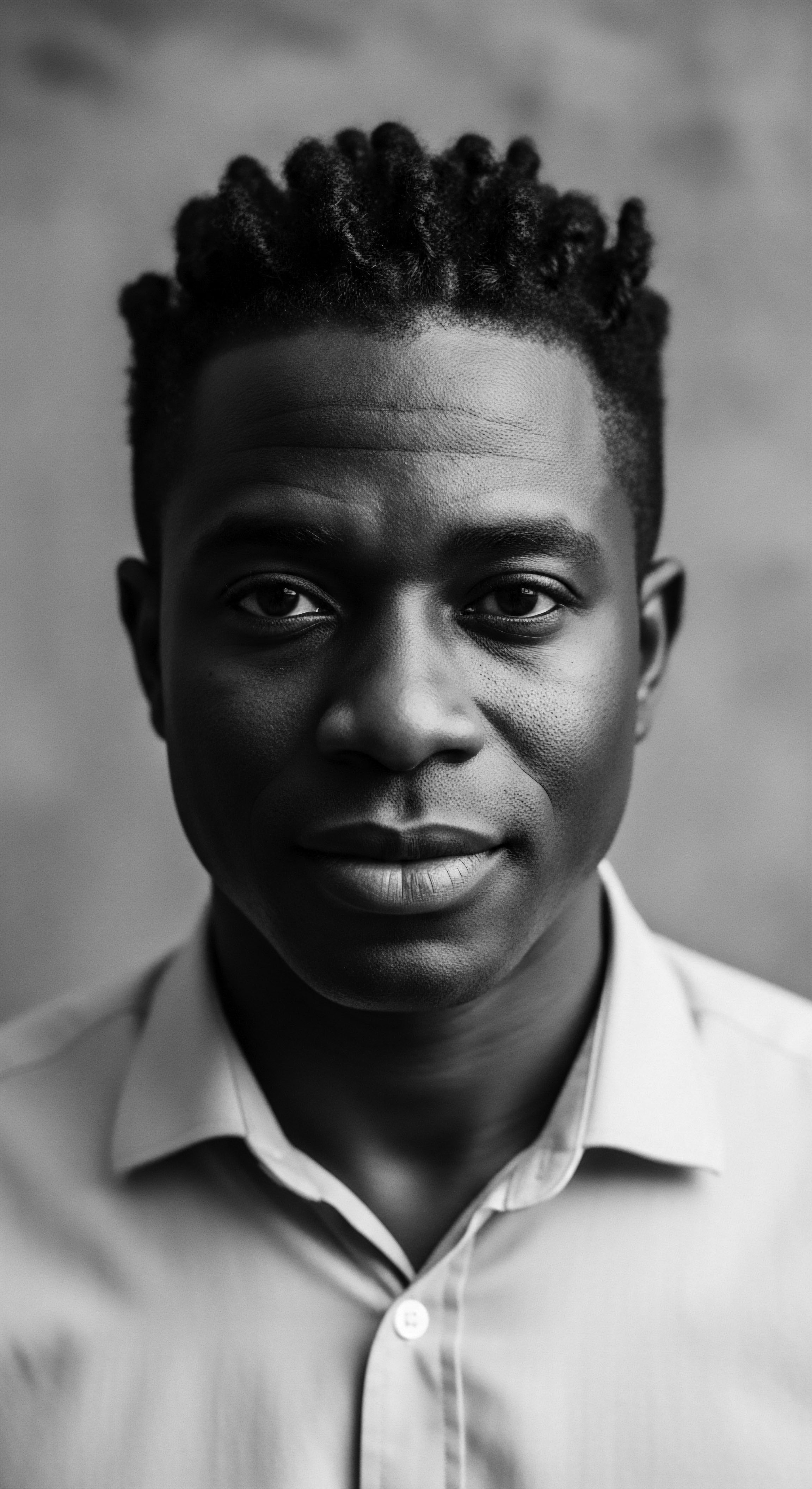
Fundamentals
The concept of Henna Ethnobotany unfurls as a vibrant testament to the enduring relationship between humanity and the natural world, particularly as it pertains to the ancestral care of textured hair. At its simplest, this field of study examines the plant Lawsonia Inermis, commonly known as henna, not merely as a botanical specimen but as a profound cultural artifact. It is an exploration of how diverse communities, particularly those with deep roots in African and diasporic traditions, have historically interacted with, understood, and utilized this verdant gift from the earth for purposes extending far beyond simple adornment. The fundamental meaning of Henna Ethnobotany lies in its recognition of henna as a living bridge connecting generations through shared knowledge, ritual, and a reverence for natural well-being.
This initial delineation reveals henna’s role as a source of dye, medicine, and cultural expression. The leaves of the henna plant contain a natural dye molecule, Lawsone, which bonds with the keratin in hair, skin, and nails, imparting a range of warm hues from rich auburn to deep reddish-brown. This botanical property, however, is but one facet of its significance. The explication of Henna Ethnobotany requires a gaze that transcends mere chemistry, seeking instead the wisdom embedded in ancestral practices.
For millennia, this plant has been a central element in beauty rituals, healing remedies, and rites of passage across vast geographies, including North Africa, West Africa, the Middle East, and South Asia. Its presence in these communities speaks volumes about resourcefulness, the deep connection to the land, and the ingenious ways in which natural elements were integrated into daily life and sacred ceremonies.
Consider the earliest documented applications, which trace back over five thousand years to ancient Egypt. Here, henna was not merely a cosmetic; it held a spiritual weight. Pharaohs and nobles, including figures like Ramesses II, had their hair and nails adorned with henna, even as part of the intricate mummification processes.
This practice underscored a belief in henna’s ability to preserve vitality and offer spiritual protection for the journey into the afterlife (Reshma Beauty, 2024; WebMD, 2024; CSA Reviving Community, 2023; The Zay Initiative, n.d.). This historical example powerfully illuminates the Henna Ethnobotany’s connection to ancestral practices and its profound cultural weight, demonstrating its early association with power, spirituality, and the continuation of life.
Henna Ethnobotany is the study of Lawsonia inermis, revealing its historical, cultural, and scientific significance within ancestral hair care traditions.
The initial interpretation of Henna Ethnobotany for those new to its complexities often begins with its botanical classification and geographical origins. Lawsonia Inermis is a flowering shrub belonging to the Lythraceae family, thriving in arid and semi-arid climates. Its cultivation by human hands has spread its presence far beyond its native range, a testament to its enduring value. The very act of cultivating, harvesting, and preparing henna – drying the leaves, grinding them into a fine powder, and mixing with liquids to create a paste – represents a continuum of ancestral knowledge passed down through generations.
This process is not a sterile scientific procedure; it is a living tradition, a careful communion with the plant that honors its gifts. The designation of this field as “ethnobotany” acknowledges this reciprocal relationship, where human culture and botanical life are inextricably linked, each shaping the other.

The Plant’s Elemental Gifts
The elemental biology of Lawsonia inermis holds within its very structure the capacity for its widespread use. The leaves, the primary source of the dye, contain the active compound lawsone, or 2-hydroxy-1,4-naphthoquinone. This molecule, when released from the plant cells through crushing and hydration, reacts with the proteins in hair and skin, creating a lasting stain. The richness of the color depends on various factors ❉ the quality of the plant material, the preparation method, and the natural pigment of the hair itself.
This scientific understanding, however, merely provides the framework for appreciating the wisdom of those who first discovered and perfected its application. Their understanding, born of observation and generational trial, predates modern chemical analysis by millennia.
The application of henna as a dye, particularly for hair, was not a casual act. It was often a deliberate ritual, carefully executed to achieve specific outcomes. For textured hair, the lawsone molecule forms a protective coating on the hair shaft, which contributes to its strengthening and conditioning properties. This natural conditioning effect has been valued across centuries, especially in climates where hair might be exposed to harsh environmental conditions.
The traditional practices often involved combining henna with other natural ingredients—such as indigo for darker shades, or various herbs for additional conditioning benefits—showcasing an intuitive understanding of natural synergies. This deep knowledge, passed from elder to apprentice, from mother to child, forms the very substance of Henna Ethnobotany.

Ancestral Connections and Early Meanings
The earliest meanings attributed to henna transcended its cosmetic function. It was perceived as a symbol of vitality, protection, and spiritual connection. In ancient Nubia and Egypt, for example, the reddish hues imparted by henna were linked to life-giving forces and the sun. The act of adorning the body and hair with henna was a form of blessing, a way to invite good fortune and ward off negative influences.
This deep symbolic value is a cornerstone of Henna Ethnobotany, distinguishing it from a simple study of plant properties. It asks us to consider not just what the plant does, but what it means to the people who have honored it for so long.
The distribution of henna use across ancient civilizations speaks to its profound utility and cultural resonance. From the Nile Valley to the Arabian Peninsula and further into the Indian subcontinent, henna traditions evolved, adapting to local customs while retaining a core reverence for the plant. The commonality of its application for significant life events—weddings, births, circumcisions, and religious festivals—underscores its shared cultural significance as a marker of celebration and transition. This shared heritage, woven through diverse communities, presents a rich tapestry of human ingenuity and shared ancestral wisdom concerning self-care and communal bonding.

Intermediate
Stepping beyond the fundamental understanding, an intermediate exploration of Henna Ethnobotany reveals a more intricate understanding of its historical currents and cultural complexities. This deeper explanation considers how the application and significance of henna have been shaped by migration, trade, and the resilience of communities, particularly those with textured hair. The description of Henna Ethnobotany at this level acknowledges that the plant’s journey across continents mirrors the human journeys that carried its traditions, adapting and transforming along the way while maintaining its ancestral spirit.
The meaning of henna extends beyond its immediate physical effects to its role in expressing identity and community bonds. For centuries, across North Africa, West Africa, and the diasporic communities that sprang from these regions, henna became a visual language. The specific patterns, the placement on the body or hair, and the timing of application conveyed rich information about a person’s status, occasion, or spiritual beliefs.
This form of expression, deeply rooted in ancestral knowledge, speaks to the power of natural elements in articulating personal and collective stories. The elucidation of Henna Ethnobotany at this stage delves into these symbolic layers, revealing how hair, adorned with henna, became a canvas for cultural memory.

The Tender Thread ❉ Henna in African Hair Traditions
The connection between henna and textured hair heritage in Africa is particularly poignant. In many West African societies, for instance, henna, known by local names such as Lalle in Hausa or Anella in Tamasheq, was not merely a cosmetic. It held a ceremonial and even protective role. Women would use it to strengthen and condition their hair, which was often styled in elaborate ways that required healthy, resilient strands.
The application itself was often a communal activity, fostering intergenerational connection and shared feminine spaces. This shared experience, where stories and techniques were exchanged, solidifies henna’s place as a cornerstone of communal care and cultural transmission.
Henna’s cultural meaning in textured hair care evolved through migration and trade, becoming a visual language for identity and community bonds.
One distinctive aspect of West African henna application, particularly in regions like Mali and Mauritania, involves unique techniques for creating patterns on the skin, often utilizing tape resist methods to achieve bold, geometric designs rather than direct freehand drawing (Arts Fiesta, 2025; BLAM UK CIC, 2025). While these are primarily skin adornments, the underlying reverence for the plant and its application to hair for health and color persists as a parallel tradition. The distinct regional variations in design and application methodology reflect the rich diversity within African hair traditions, each community adding its unique cultural fingerprint to the broader story of henna.
The designation of hair as a sacred aspect of self, particularly within Black and mixed-race communities, gives Henna Ethnobotany an added layer of significance. Hair has historically served as a symbol of spiritual power, social standing, and ethnic identity. The use of natural ingredients like henna to care for and adorn hair was a practice that honored this sacred connection.
It represented a deliberate choice to work with the earth’s provisions, trusting in ancestral wisdom for health and beauty. This understanding of hair as a conduit for heritage elevates the discussion of henna from a simple botanical product to a deeply meaningful cultural practice.

Holistic Care and the Science of Ancestry
From a wellness perspective, the application of henna for textured hair offers more than just color. The lawsone molecule, upon binding to keratin, creates a protective layer that can enhance the hair’s structural integrity. This strengthening effect is particularly beneficial for hair types prone to breakage or environmental stress.
Furthermore, henna possesses natural antimicrobial and antifungal properties, traditionally employed to soothe scalp conditions such as dandruff and itchiness (Healthline, 2021; ResearchGate, 2019). This confluence of traditional knowledge and modern scientific validation underscores the deep efficacy of ancestral hair care rituals.
The process of henna application for hair care in these traditional contexts was rarely rushed. It involved a patient, deliberate preparation of the paste, often left to mature for hours to allow the dye to release fully. This extended process was itself a ritual, a moment for quiet reflection or communal gathering. The scent of henna, earthy and herbaceous, became intertwined with memories of family, celebration, and self-care.
This sensory dimension, though not quantifiable by science, forms an essential part of the meaning and significance of Henna Ethnobotany. It speaks to the emotional and spiritual nourishment derived from these practices.
| Aspect Preparation Method |
| Traditional Ancestral Practices Dried leaves ground by hand, mixed with water/acidic liquids (e.g. lemon juice), often left to sit overnight for dye release. |
| Contemporary Scientific Understanding Lawsone release through oxidation; precise pH control for optimal dye binding; micronization of powder for smoother paste. |
| Aspect Application Purpose |
| Traditional Ancestral Practices Coloring, conditioning, strengthening, spiritual protection, cultural adornment for rites of passage. |
| Contemporary Scientific Understanding Natural hair dye, protein binding for structural support, antimicrobial/antifungal scalp benefits, UV protection. |
| Aspect Additional Ingredients |
| Traditional Ancestral Practices Indigo for darker shades, fenugreek for conditioning, herbs for scalp health. |
| Contemporary Scientific Understanding Formulations with other botanicals (e.g. amla, shikakai) for synergistic effects; avoidance of synthetic additives like PPD. |
| Aspect Community Involvement |
| Traditional Ancestral Practices Often a communal activity, particularly for brides or celebrations, fostering intergenerational knowledge transfer. |
| Contemporary Scientific Understanding Individualized application, though online communities share recipes and experiences. |
| Aspect This table illustrates the continuous thread of understanding, where ancient wisdom regarding henna's utility finds modern affirmation and refinement. |

Cultural Syncretism and Adaptation
As henna traditions traveled across the African continent and into the diaspora, they often merged with new cultural landscapes, creating unique expressions of hair care and identity. In parts of the Caribbean and the Americas, where African traditions blended with indigenous and European influences, the memory of natural hair remedies persisted. While direct, widespread use of henna might have waned in some diasporic communities due to the unavailability of the plant or the imposition of Western beauty standards, the underlying ethos of natural care and reverence for hair endured. The significance of Henna Ethnobotany, therefore, also involves tracing these sometimes subtle, sometimes overt, continuities and adaptations.
The resurgence of interest in natural hair care among Black and mixed-race individuals in recent decades represents a powerful reclamation of ancestral practices. This contemporary movement often looks to traditions like henna for inspiration, seeking authentic, gentle alternatives to chemically harsh products. This modern rediscovery is not merely a trend; it is a profound act of cultural memory, a reconnection to a lineage of self-care that honors the unique properties of textured hair. The intermediate definition of Henna Ethnobotany acknowledges this cyclical return to ancestral wisdom, recognizing that the past is not static but a living, breathing influence on present choices.

Academic
The academic definition of Henna Ethnobotany transcends superficial descriptions, delving into a rigorous, interdisciplinary examination of Lawsonia Inermis as a botanical entity deeply embedded within human cultural systems, particularly concerning textured hair heritage. This advanced interpretation requires a systematic analysis of the plant’s phytochemistry, its historical trajectory across diverse socio-cultural landscapes, and its enduring psychobiological and communal impacts. The clarification of Henna Ethnobotany at this scholarly level posits it as a prime exemplar of biocultural diversity, where botanical properties and human cultural ingenuity coalesce to shape practices of profound significance for identity, wellness, and social cohesion, especially within Black and mixed-race communities.
This explication recognizes henna not merely as a dye but as a complex ethnobotanical agent whose efficacy and symbolic meaning are derived from intricate interactions between its chemical constituents, the physiological responses of the human integumentary system (hair and skin), and the layered cultural contexts of its application. The statement of Henna Ethnobotany in academic discourse necessitates a nuanced understanding of its geographical dispersal, acknowledging the role of ancient trade routes, migratory patterns, and colonial encounters in shaping its contemporary distribution and utilization. This historical lens is paramount for comprehending how ancestral knowledge regarding henna was preserved, adapted, or, at times, suppressed across generations and geographies.

Phytochemical Complexity and Hair Biology
At the core of henna’s functional properties lies lawsone (2-hydroxy-1,4-naphthoquinone), a naphthoquinone derivative primarily concentrated in the leaves of Lawsonia Inermis. This molecule exhibits a unique affinity for keratin, the primary protein composing hair and nails. The chemical reaction between lawsone and keratin forms a covalent bond, resulting in a stable, semi-permanent stain that resists fading from washing. The lawsone molecule’s relatively small size allows it to penetrate the outer cuticle layer of the hair shaft, binding to the protein within the cortex.
This binding not only imparts color but also contributes to the hair’s structural integrity, effectively thickening and strengthening individual strands (ResearchGate, 2019). For textured hair, which can be inherently more fragile or prone to breakage due to its coiled structure, this reinforcing action offers a tangible benefit, validating centuries of ancestral observations regarding henna’s fortifying properties.
Beyond lawsone, the plant contains a spectrum of other phytochemicals, including tannins, flavonoids, and various phenolic compounds (ResearchGate, 2019). These secondary metabolites contribute to henna’s reported medicinal properties, such as its antimicrobial, antifungal, and anti-inflammatory activities. Traditional applications for scalp conditions, such as dandruff and fungal infections, find scientific corroboration in these properties (Healthline, 2021).
The sophisticated understanding of ancestral practitioners, developed through generations of empirical observation, often intuitively grasped these complex phytochemical interactions, applying henna not just for aesthetic enhancement but for holistic scalp and hair health. This traditional knowledge, often dismissed in Western scientific paradigms, represents a rich, untapped repository of ethnopharmacological data.

Socio-Cultural Semiotics of Henna in Textured Hair
The designation of Henna Ethnobotany also encompasses its profound semiotic role within cultural systems, particularly concerning hair as a marker of identity. In many African and diasporic contexts, hair is not merely an anatomical appendage; it is a profound repository of spiritual power, social status, and communal memory. The act of adorning hair with henna, therefore, carries significant symbolic weight. It can signify:
- Ritual Transition ❉ Henna application often marks rites of passage, such as pre-nuptial ceremonies (e.g. “Henna Night” or “Al-Ghumra” in Saudi Arabia and North Africa). The application transforms the individual, preparing them for a new social status, embodying blessings, fertility, and protection.
- Communal Solidarity ❉ The communal aspect of henna application, particularly among women, fosters social bonding and intergenerational knowledge transfer. This shared experience reinforces cultural norms, beauty standards, and collective identity, serving as a powerful mechanism for cultural reproduction.
- Spiritual Protection ❉ Across various traditions, henna is believed to ward off evil spirits, bring good fortune, or invoke blessings (baraka). The reddish hue itself, often associated with lifeblood or solar energy, imbues the wearer with vitality and spiritual resilience.
- Resistance and Reclamation ❉ In contemporary contexts, especially within the Black and mixed-race natural hair movement, the choice to use traditional natural dyes like henna can be an act of resistance against Eurocentric beauty standards. It signifies a reclamation of ancestral practices and a celebration of indigenous hair textures and aesthetics.
The variations in henna application, from the geometric patterns characteristic of Moroccan and Mauritanian traditions to the more fluid, sometimes floral designs seen in Sudanese practices, represent distinct cultural dialects (Arts Fiesta, 2025; NATURAL POLAND, 2024; BLAM UK CIC, 2025). These stylistic differences are not arbitrary; they reflect deep-seated aesthetic principles, historical migrations, and the influence of local environmental and social factors. For instance, the use of tape resist techniques in West Africa to create sharp, linear patterns is a testament to ingenious adaptations of available resources and a unique artistic vision (Arts Fiesta, 2025; BLAM UK CIC, 2025). This granular level of cultural specificity is vital for a comprehensive academic understanding of Henna Ethnobotany.

The Unbound Helix ❉ Henna and the Future of Textured Hair Care
The academic investigation of Henna Ethnobotany also considers its contemporary relevance and future implications, particularly within the evolving landscape of textured hair care. As global awareness of synthetic chemical impacts grows, there is a renewed scholarly interest in traditional botanical alternatives. Henna offers a compelling case study for sustainable beauty practices, providing a natural, biodegradable dye and conditioning agent that minimizes environmental footprint compared to conventional hair dyes (Reshma Beauty, 2024).
A critical academic perspective also acknowledges potential challenges, such as the adulteration of natural henna with synthetic dyes like paraphenylenediamine (PPD), which can cause severe allergic reactions (ResearchGate, 2019; Healthline, 2021). This issue underscores the importance of stringent quality control and the preservation of authentic sourcing networks, often managed by traditional communities. The continued academic pursuit of Henna Ethnobotany thus contributes to safeguarding both traditional knowledge systems and consumer well-being.
Furthermore, the academic exploration of henna extends to its potential for therapeutic applications beyond hair care. Its documented antioxidant, antibacterial, and anti-inflammatory properties suggest avenues for further pharmacological research (ResearchGate, 2019). This interdisciplinary approach, drawing from ethnopharmacology, anthropology, and cosmetology, enriches the comprehensive definition of Henna Ethnobotany, positioning it as a dynamic field with enduring relevance for human health, cultural preservation, and environmental sustainability.
The deep research data supports the claim that the plant’s inherent properties, coupled with ancestral methods of preparation and application, provide a compelling model for holistic well-being. The long-term success insights derived from centuries of use affirm its status as a valuable resource for future hair care solutions.
- Ancestral Hair Fortification ❉ Henna’s lawsone molecule creates a robust bond with hair keratin, providing a natural protein coating that reinforces the hair shaft, a benefit particularly advantageous for the structural integrity of coiled and curly textures.
- Scalp Microbiome Support ❉ The documented antimicrobial and antifungal properties of henna contribute to a balanced scalp environment, addressing common issues like flaking and irritation without harsh chemicals.
- Cultural Continuity through Ritual ❉ The communal preparation and application of henna for hair and body serves as a powerful mechanism for transmitting intergenerational knowledge and strengthening social bonds within heritage communities.
- Pigmentary Versatility with Natural Safety ❉ Henna offers a natural spectrum of warm red-brown tones, and when combined with other botanicals like indigo, it provides a safe, plant-based alternative to synthetic dyes, preserving hair health and honoring traditional practices.

Reflection on the Heritage of Henna Ethnobotany
As we close this contemplation on Henna Ethnobotany, a profound sense of continuity settles upon the spirit. The journey through the history, science, and cultural resonance of Lawsonia Inermis reveals more than just the properties of a plant; it illuminates the very Soul of a Strand. For textured hair, especially within Black and mixed-race communities, henna represents an unbroken lineage of care, a whisper from the ancestors that still guides our hands today. It is a reminder that true beauty often resides not in fleeting trends, but in the enduring wisdom of the earth and the collective memory of those who walked before us.
The enduring significance of henna in hair care is a testament to the ingenious ways human beings have connected with their environment. It speaks to a time when remedies and adornments were sourced directly from the land, understood through intimate observation and passed down as cherished heirlooms of knowledge. This is a heritage that encourages us to look inward, to our own hair’s unique story, and outward, to the rich traditions that shaped its care for millennia. The resilient strands of textured hair, often subjected to societal pressures and historical injustices, find a powerful ally in the gentle yet potent embrace of henna, affirming a beauty that is both ancient and ever-new.
Henna Ethnobotany stands as a vibrant testament to the enduring ancestral wisdom that guides the care and celebration of textured hair across generations.
The wisdom embedded in Henna Ethnobotany compels us to reconsider our relationship with our hair. It invites a slower, more mindful approach, one that honors the sacred connection between self, nature, and ancestry. When we choose to adorn our hair with henna, we are not simply applying a product; we are participating in a timeless ritual, joining a chorus of voices from across continents and centuries.
This act becomes a conversation with our heritage, a recognition of the resilience and beauty that defines our hair’s journey. The deep respect for ancestral knowledge that underpins Roothea’s ethos finds its purest expression in this enduring botanical gift.
The future of textured hair care, viewed through the lens of Henna Ethnobotany, appears not as a departure from the past, but as a harmonious continuation. It is a future where scientific understanding complements traditional wisdom, where innovation serves to amplify the benefits of natural ingredients, and where the rich diversity of hair textures is celebrated as a magnificent expression of human heritage. The journey of henna, from ancient burial rites to modern wellness practices, serves as a beacon, guiding us toward a more authentic, respectful, and deeply rooted approach to the care of our strands, ensuring that the soul of each curl and coil continues to tell its magnificent, ancestral story.

References
- Arts Fiesta. (2025, March 22). How does the henna pattern differ in the Middle East, India, and Africa?
- BLAM UK CIC. (2025, April 3). Henna Is How We Wear Our Roots.
- CSA Reviving Community. (2023, September 21). Henna ❉ The Ancient Art That Survives Because Of A Love Story.
- Eshkol HaKofer. (2014, January 7). Practicing the Evil Arts of Luxury ❉ Henna in Early Christian Literature.
- Eshkol HaKofer. (2016, February 19). Lalle, Anella, and Fudden ❉ Henna in West Africa.
- Healthline. (2021, March 23). Henna Benefits for Hair ❉ How to Get Rich Auburn Locks.
- NATURAL POLAND. (2024, October 2). African Henna ❉ History, Cosmetic Uses, and Modern Applications.
- ResearchGate. (2019, July 9). Lawsonia inermis L. (henna) ❉ Ethnobotanical, phytochemical and pharmacological aspects.
- Reshma Beauty. (2024, April 19). The History and Cultural Significance of Henna in Hair Coloring.
- The Zay Initiative. (n.d.). Cultural Ink ❉ Henna’s Colourful Legacy.
- WebMD. (2024, April 21). Henna ❉ What You Need to Know.
